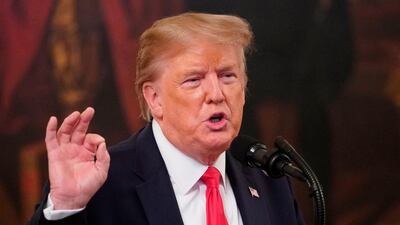Oil prices gained after two days of decline, following a dramatic week for the markets, which recorded the highest rallies in more than two decades.
Brent was trading at $62.80 at 9.24am UAE time, after the US President Donald Trump said he would increase sanctions on Iran, accusing the country of being responsible for Saturday's attacks on Saudi Aramco facilities. The incident that took 5.7 million barrels per day of Saudi output offline, the equivalent of 5 per cent of global supply.
West Texas Intermediate, the benchmark tracking largely North American crude grades was also up trading at $58.23 per barrel.
The details of the latest round of sanctions announced by Mr Trump on Wednesday are expected to be available in 48 hours.
"I have just instructed the Secretary of the Treasury to substantially increase sanctions on the country of Iran!” Mr Trump said on Twitter.
He also named the hawkish Robert O'Brien as his National Security Adviser, following the dismissal of John Bolton, who had spearheaded the White House's "maximum pressure" campaign against Tehran, including the measures to squeeze its oil exports to zero.
The appointment comes amid renewed tensions in the Middle East, after attacks targeted an oil stabilisation facility in Abqaiq in Saudi Arabia as well as the Khurais oilfield, located 200 kilometres south-west.
The 7-million-bpd capacity Abqaiq facility is the largest of its kind where crude sourced from some of the world's expansive oilfields in the Eastern Province of Saudi Arabia is "sweetened". The processing removes volatile compounds from crude, making it safer for transport. The outage was the biggest supply shock to the global oil markets, according to the International Energy Agency, superseding similar volumes during the 1979 Iranian revolution which toppled the Shah and the 1991 invasion of Kuwait by Saddam Hussein, according to the IEA.
By Tuesday, Saudi Arabia said it had recovered about half of the lost output, with production expected to be restored by the end of September.
The kingdom said production capacity of 11 million bpd will come onstream by the month-end and 12 million bpd is expected to be reached by November.
Saudi Arabia’s new Energy Minister Prince Abdulaziz bin Salman, only in the second week of his job, declared the attacks “an act of war” on Tuesday. He said Aramco will continue to honour its export requirements and would reduce domestic refinery runs by 1 million bpd to 1.9 million bpd.
Facts Global Energy in London expects Saudi Arabia to prioritise its crude exports over product exports, cutting back on feedstock to domestic refiners. The kingdom's downstream industry has declared a 40 per cent decline in available feedstock after the attacks.
The consultancy expects Brent to trade between in the range of $60 to $65 and $65 to $70 per barrel in the fourth quarter, on the assumption that Saudi Arabia's crude output recovery could possibly be slower than expected.
Abqaiq could take months to repair with nearby plants such as Khursaniyah being optimised for gas processing.
"Under this scenario, we expect Saudi Arabia’s crude production to average around 8 million bpd in September, recovering to around 8.8 million bpd before further recovery is realised in November ahead of full capacity being made available in December," FGE said.


